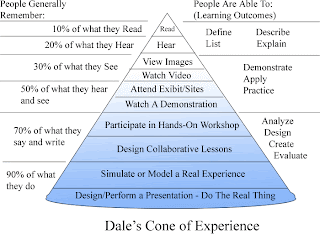Dale’s Cone of Experience
Years ago, an educator named Edgar Dale (Educational Media, 1960), developed from his experience in teaching and his observations of learners the "cone of experience”.The cone's utility in selecting instructional resources and activities is as practical today as when Dale created it. That's why he is often cited as the father of modern media in education.
But, what is The cone of experience?
The cone of experience is a pictorial device used to explain the interrelationships of the various types of audio-visual media, as well as their individual “positions” in the learning process. The cone implemented a series of varied experience of the basic to enhanced learning experience with the intent to immerse the learner further within the subject matter in order to retain a great knowledge of material.
From the illustration, general straight line of explanation is that people generaly remember 10%
of what they read, 20%
of what they hear, 30%
of what they see, 50%
of what they hear and see - video, 70%
of what they say or write, and 90%
of what they say as they do something.
The application of this scheme can contribute many important things for learning and teaching activities on the classroom. It can help teacher to make the decisions about the suitable resources and activities as the cone gives the information about the percentage of each part of skill. It also enhances
the ability of a learner to retain the subject matter, Invites
learners to practice the subject matter in action learning, and motivates
students to interact actively each other.
But in certain case, it is also difficult and gives disadvantages for classroom activities. For example, on the stage of verbal symbol, students face highly
abstract material to learn. It is very difficult for young learner as they have to learn something real. Besides, the
lack of ability in using media leads misconception for the learners. Moreover, it is difficult
in designing real life experiences condition for different students’ cognitive and it also takes much time for direct purposeful experience.
But those weakness can be solved as the development of technology is increasing. In fact, this concept can collaborate with the existance of internet and computer technology (ICT). Here, ICT helps learners retain more information
in learning. We can search reading articles or listening material in order to learn. Besides that, ICT also helps teachers designs instructional activities such as use special software to
design material, enables students move beyond other stages, and also combines abstract learning and concrete experience become meaningful learning.
For more information about cone of experience, watch these videos...
And if you are a teacher, this video might be very powerful for your teaching







